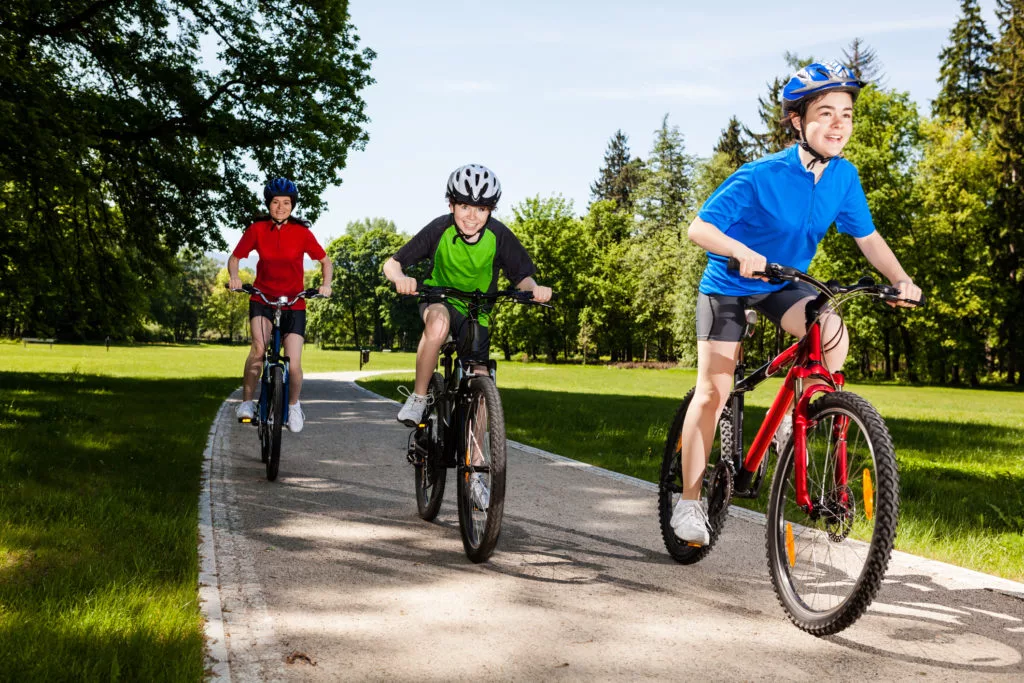Staying Safe on Two Wheels

Bicycle riding is a popular mode of transportation and source of recreation for children and adolescents. But bicycle riding does come with an increased risk of injuries, including serious and sometimes fatal head injuries. Children and adolescents account for more than one-third of all bicycle-related injuries seen in U.S. emergency departments. The good news is, by following these injury-preventing strategies, the risks of bicycle riding can be drastically reduced.
Always wear a helmet!
An estimated 140,000 children are treated each year in emergency departments in the U.S. for traumatic brain injuries sustained while riding a bicycle. Bicycle helmets have been shown to reduce overall head injuries by 60% and reduce fatalities by more than 70%.
For a helmet to work as effectively as possible, proper fit is crucial. As much fun as it is to surprise someone with a gift of a cool new helmet, it is very important to have the rider present when buying a helmet. When shopping for a helmet, make sure it is U.S. Consumer Product Safety Commission (CPSC) certified, which means it meets the federal safety standard.
- The helmet should fit snugly with no spaces between the foam and the rider’s head. Many helmets have removable padding or an adjustable strap inside to ensure a snug fit. The padding in the front should be one to two finger widths above the rider’s eyebrows and the back should not touch the rider’s neck.
- Make sure you can see your child’s eyes and that he/she has a clear view forward and side to side.
- Side straps should make a “V” shape under and slightly in front of the rider’s ears. The chin strap should fit so that no more than one or two fingers fit between the chin and the strap. When your child opens his/her mouth wide, the helmet should pull down slightly.
Once these steps are completed, the helmet should not move front to back or side to side. For more information, check out the CDC fact sheet about helmet safety.
Helmets are not just for children. Wearing a helmet prevents serious head injuries at all ages. Remember, you are a role model to your children – they will be more willing to wear theirs if you wear yours.
Choosing a Bicycle
Children can start learning to ride a bicycle as early as three years old. By six years old, most children are able to ride a bicycle without training wheels. Again, proper fit is crucial — avoid buying a larger bicycle for your child to “grow into.”
- A tricycle should have wheels 12-13 inches in diameter.
- A small bicycle with training wheels can be used but should have foot breaks (not hand breaks).
- Your child should be able to sit on the seat and touch the balls of his or her feet to the ground while holding the handlebars.
- When straddling the bicycle with both feet flat on the ground, there should be one inch of clearance between the bar and the rider’s crotch.
Learning to ride
Among children younger than 14 years old, most bicycle fatalities are associated with bicyclist’s behavior, such as not following the rules of the road. Children under 6 should be taught to ride in areas without cars or other motor vehicles, such as parks or playgrounds. After this, children should ride on the sidewalk until the age of 10 and should always ride with an adult present. Before learning to ride on the street, all bicyclists need to learn the rules of the road:
- Ride with traffic – NEVER ride against traffic
- Ride in single file
- Stop and look both ways before entering the street
- Stop at all intersections, whether or not they are marked.
- Walk your bike across busy intersections.
- Use bicycle paths when possible
- Use hand signals when turning so other cyclists and cars know what you are going to do next.
- Avoid wearing loose fitted clothing, make sure there are no loose straps or laces that can get caught in the wheels or chain
- Never wear headphones while riding
Now that you know how to keep your child safe on his/her bicycle, remember, you are your child’s most important role model. Riding your bicycle as a family and modeling these safety tips could save your life and theirs!

